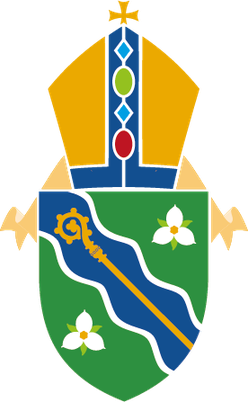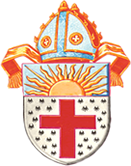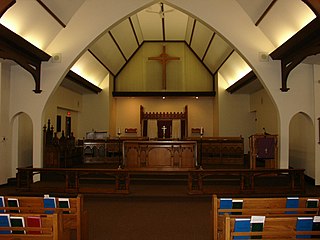Related Research Articles

The Anglican Church of Canada is the province of the Anglican Communion in Canada. The official French-language name is l'Église anglicane du Canada. In 2022, the Anglican Church counted 294,931 members on parish rolls in 1,978 congregations, organized into 1,498 parishes. The 2021 Canadian census counted 1,134,315 self-identified Anglicans, making the Anglican Church the third-largest Canadian church after the Catholic Church and the United Church of Canada.
The Anglican Diocese of Eastern Newfoundland and Labrador is one of seven dioceses of the Ecclesiastical Province of Canada in the Anglican Church of Canada. As of 2012 the diocese had 50,000 members in 81 congregations organised in 35 parishes. The most widely spread parish has thirteen congregations.
The Anglican Diocese of Western Newfoundland is a diocese of the Ecclesiastical Province of Canada of the Anglican Church of Canada. It comprises 77 congregations grouped in 30 parishes in Western Newfoundland, with approximately 17,888 souls. Most parishes are multipoint - with more than two congregations - with only one full-time clergy. As of 2012, the diocese had 20 full-time and over 350 lay ministers. As of 2019, this Diocese allows clergy to officiate same-sex marriages.

The Diocese of Nova Scotia and Prince Edward Island is a diocese of the Ecclesiastical Province of Canada of the Anglican Church of Canada. It encompasses the provinces of Nova Scotia and Prince Edward Island and has two cathedrals: All Saints' in Halifax and St. Peter's in Charlottetown. Its de facto see city is Halifax, and its roughly 24 400 Anglicans distributed in 239 congregations are served by approximately 153 clergy and 330 lay readers according to the last available data. According to the 2001 census, 120,315 Nova Scotians identified themselves as Anglicans, while 6525 Prince Edward Islanders did the same.

The Diocese of Niagara is one of thirty regional divisions in the Anglican Church of Canada. The see city of the diocese is Hamilton, with the bishop's cathedra located at Christ's Church Cathedral on James Street North. Located within the ecclesiastical province of Ontario, it borders the Dioceses of Huron and Toronto. The area enclosed by the Diocese of Niagara includes much of the Golden Horseshoe, and moves north to include Erin and Orangeville as far as Shelburne. Moving sharply south, the boundary includes Mount Forest and widens, south-westerly to include Elora and Guelph. Skirting Brantford and the Territory of the Six Nations Confederacy, the line then travels, again, south-westerly to Jarvis and Lake Erie to include the entire Niagara Peninsula. Major urban centres within its borders are St. Catharines, Niagara Falls, Hamilton, Guelph, Oakville, Milton, Burlington, and Orangeville.

The Diocese of Qu'Appelle in the Anglican Church of Canada lies in the southern third of the civil province of Saskatchewan and contains within its geographical boundaries some 50 per cent of the province's population of one million.
The Diocese of Toronto is an administrative division of the Anglican Church of Canada covering the central part of southern Ontario. It was founded in 1839 and is the oldest of the seven dioceses comprising the Ecclesiastical Province of Ontario. It has the most members of any Anglican diocese in Canada. It is also one of the biggest Anglican dioceses in the Americas in terms of numbers of parishioners, clergy and parishes. As of 2018, the diocese has around 230 congregations and ministries in 183 parishes, with approximately 54,000 Anglicans identified on parish rolls.
The Ecclesiastical Province of British Columbia and Yukon is one of four ecclesiastical provinces in the Anglican Church of Canada. It was founded in 1914 as the Ecclesiastical Province of British Columbia, but changed its name in 1943 when the Diocese of Yukon was incorporated from the Ecclesiastical Province of Rupert's Land. The territory covered by the province encompasses the civil province of British Columbia and Yukon. There are five dioceses and one "recognized territory [with] the status of a diocese" in the province:

St Paul's Cathedral, Kamloops, is the Cathedral church for the Territory of the People, Anglican Church of Canada. The Territory of the People was formerly known as the Diocese of Cariboo, which was dissolved because of its inability to meet tort judgments against it in respect of abuse in Indian residential schools. After dissolution of the Diocese of the Cariboo the Territory was temporarily known as The Anglican Parishes of the Central Interior. The area officially became a territory in 2015.

The Diocese of British Columbia, also known as the Anglican Diocese of Islands and Inlets, is a diocese of the Ecclesiastical Province of British Columbia and Yukon of the Anglican Church of Canada.
The Diocese of Huron is a diocese of the Ecclesiastical Province of Ontario of the Anglican Church of Canada. The diocese comprises just over 31,000 square kilometres in southwestern Ontario, sandwiched between Lake Huron and Lake Erie. Its See city is London, and its parish rolls of 50,000 are served by 177 congregations.

The Diocese of The Arctic is a diocese of the Ecclesiastical Province of Rupert's Land of the Anglican Church of Canada. It is by far the largest of the thirty dioceses in Canada, comprising almost 4,000,000 km2 (1,500,000 sq mi), or one-third the land mass of the country. As the name indicates, the diocese encompasses the Arctic region of Canada including the entirety of the Northwest Territories, Nunavut, and the Nunavik region of northern Quebec. The see city is Iqaluit, Nunavut, and the diocese's nearly 34,000 Anglicans are served by 48 parishes. The administrative offices of the diocese are located in Yellowknife, Northwest Territories.

The Diocese of Rupert's Land is a diocese of the Ecclesiastical Province of Rupert's Land of the Anglican Church of Canada. It is named for the historical British North American territory of Rupert's Land, which was contained within the original diocesan boundaries.
The Anglican Diocese of Athabasca is a diocese of the Ecclesiastical Province of Rupert's Land of the Anglican Church of Canada, in the northern half of the civil province of Alberta. It was created in 1874 by the division into four parts of the original Diocese of Rupert's Land. The Synod of the Diocese of Athabasca was organized in 1876. The diocese was then itself subdivided in 1892 to create the new dioceses of Selkirk and Mackenzie River and in 1933 to create the Diocese of The Arctic.
The Diocese of Cariboo was a diocese of the Ecclesiastical Province of British Columbia and the Yukon of the Anglican Church of Canada. Incorporated in 1914, the diocese ceased operations on December 31, 2001 when the financial strain of legal costs from third party claims made by the Government of Canada, associated with damage suits brought by former students of the Anglican-run St George's Indian Residential School in Lytton, B.C., exhausted the diocese financially.
The Diocese of Kootenay is a diocese of the Ecclesiastical Province of British Columbia and the Yukon of the Anglican Church of Canada.
The Diocese of Yukon is a diocese of the Ecclesiastical Province of British Columbia and Yukon of the Anglican Church of Canada. It comprises 13 parishes across the Yukon and parts of northern British Columbia.
The Anglican Church of Canada is the third largest church in Canada, after the Roman Catholic Church and the United Church of Canada. After many years of debate, the first blessing of a same-sex partnership took place in 2003, by the Diocese of New Westminster, in Vancouver. This was not considered a marriage ceremony, but rather a blessing of "permanent and faithful commitments" between persons of the same sex.
Clara Plamondon is a Canadian Anglican bishop. Since 2024, she has been the second bishop of the Territory of the People in the Ecclesiastical Province of British Columbia and Yukon.
References
- 1 2 Elliot, Neil (15 March 2024). "Dioceses of the ACC – by numbers". Numbers Matters. (Neil Elliot is the statistics officer for the Anglican Church of Canada.). Retrieved 17 March 2024.
- ↑ Territory of the People — About (Accessed 23 February 2017)
- 1 2 Anglican Church of Canada — APCI enters new territory with name change (Accessed 23 February 2017)
- 1 2 Anglican Church of Canada — Highlights from the Council of General Synod: November 14, 2015 (Accessed 16 November 2015)
- ↑ Blair, Kathy (1 September 2000). "Diocese of Cariboo plans own shutdown". Anglican Journal. Archived from the original on 2002-01-13.
- ↑ "Letter from Archbishop McNaughton" (PDF). Territory of the People. Archived from the original (PDF) on 21 August 2022. Retrieved 21 August 2022.
- ↑ "Territory of the People bishop resigns after sexual misconduct allegations". Anglican Journal. 1 September 2021. Archived from the original on 25 July 2022. Retrieved 21 August 2022.
- ↑ "Appointment of Assisting Bishop for the Territory". Territory of the People. Archived from the original on 21 August 2022. Retrieved 21 August 2022.